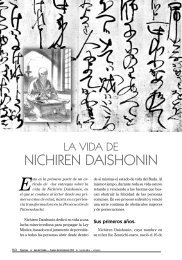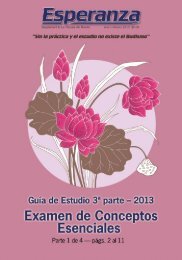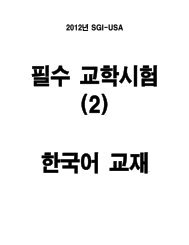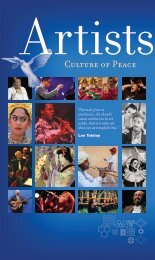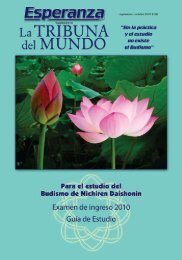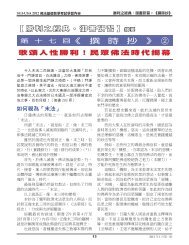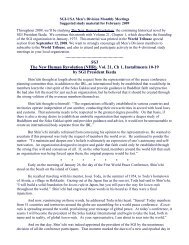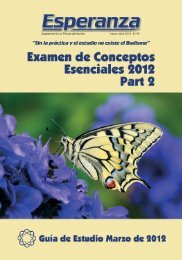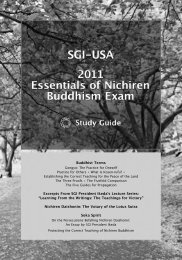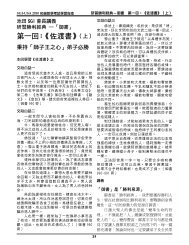Download PDF of Exhibit - SGI-USA
Download PDF of Exhibit - SGI-USA
Download PDF of Exhibit - SGI-USA
Create successful ePaper yourself
Turn your PDF publications into a flip-book with our unique Google optimized e-Paper software.
Buildinga Culture <strong>of</strong>PeaceFor the Children<strong>of</strong> the WorldThis exhibit brings together the ideas <strong>of</strong>hundreds <strong>of</strong> people and organizations dedicatedto finding a path to lasting peace.We hope that you will leave with renewedconfidence that a culture <strong>of</strong> peace is possible—and a necessity for life on earth.Everything that is needed to build a culture <strong>of</strong>peace already exists in each <strong>of</strong> our hearts. Asstated in the United Nations definition, a Culture<strong>of</strong> Peace is a set <strong>of</strong> values, attitudes, modes <strong>of</strong>behavior and ways <strong>of</strong> life that reject violence andprevent conflicts by tackling their root causes andsolving problems through dialogue and negotiationamong individuals, groups and nations.
Barriers to PeaceEnvironmentalIrresponsibilityPollution and the destruction <strong>of</strong> thenatural environment require solutionsthat go beyond national boundaries.Global warming could cause 40 to 50percent <strong>of</strong> the world’s population to beaffected by insect-transmitted diseasessuch as malaria and dengue fever.IsolationismPeople can become frightened by the risingtide <strong>of</strong> internationalism. Some retreat t<strong>of</strong>amiliar places and customs and avoidencounters with “foreigners.”Ignorance <strong>of</strong> other cultures and countries createsa narrow, distorted view <strong>of</strong> life and the world.Education is key to fostering global-mindedindividuals.“It is not the violence <strong>of</strong> a fewthat scares me,it is the silence <strong>of</strong> the many.”—Martin Luther King, Jr.PovertyNeed is the root cause <strong>of</strong> many <strong>of</strong> theconflicts in the world. Where childrenare hungry, there can be no peace.78% <strong>of</strong> Sub-Saharan Africans and 84%<strong>of</strong> South Asians live on less than $2 a day.Of the world’s 1.3 billion poor people, it isestimated that nearly 70 % are women.GreedA struggle between powers forterritorial dominance led to twoWorld Wars and the Cold War.The struggle now is for economicdomination.Europe consumes roughly 14 timesthe resources it contains. The UnitedStates, with just over 4 % <strong>of</strong> theworld’s people, consumes 28% <strong>of</strong> worldresources. Japan, with about 2% <strong>of</strong> theworld population, is the world’s 4thlargest energy consumer. More than80% <strong>of</strong> Japan’s energy is imported.Nuclear ThreatNuclear weapons are the ultimateembodiment <strong>of</strong> human negativity. Abalance <strong>of</strong> nuclear power is impossible.There are enough nuclear weaponsstockpiled to devastate the Earth andkill every person on the planet severaltimes over.The Illusion <strong>of</strong>“Efficiency”In the technocratic view that places theutmost value on technological progress,efficiency and expediency, human beingsare reduced to things.Prejudice andStereotypingTo motivate people to make war, the enemymust be a recognizable evil—a stereotype.Prejudice and hate are fueled by ignorance.“All war is based on deception.”—The Art <strong>of</strong>War, by Sun Tzu, circa 500 BCEThis dehumanizing tendency is starklyevident in the language <strong>of</strong> war planningwhere the death <strong>of</strong> innocent people becomes“collateral damage,” attacks become “strikes,”and “liquidation” and “neutralize” becomeeuphemisms for killing.
The United Nationsand the Culture <strong>of</strong> PeaceAs defined by the UnitedNations, the Culture <strong>of</strong> Peaceis a set <strong>of</strong> values, attitudes,modes <strong>of</strong> behavior andways <strong>of</strong> life that reject violenceand prevent conflicts bytackling their root causesto solve problems throughdialogue and negotiationamong individuals, groupsand nations.1989199719992000A “culture <strong>of</strong> peace” was firstexpressed <strong>of</strong>ficially at theInternational Congress on Peacein the Minds <strong>of</strong> People held inIvory Coast, Africa.UN designated the year 2000 the“International Year for the Culture<strong>of</strong> Peace.”On September 13, the UNGeneral Assembly adopted the“Declaration on a Culture <strong>of</strong>Peace” and the “Programme <strong>of</strong>Action on a Culture <strong>of</strong> Peace.”“International Year for a Culture<strong>of</strong> Peace” UNESCO supportedthe Manifesto 2000 signaturecollectingcampaign.2001Start <strong>of</strong> the “International Decadefor a Culture <strong>of</strong> Peace and Non-Violence for the Children <strong>of</strong> theWorld.”
The Pattern<strong>of</strong> PeaceThe Culture <strong>of</strong> Peaceis made up <strong>of</strong> aninfinite number <strong>of</strong>interlocking pieces.Each <strong>of</strong> us hasa part to play inthe pattern <strong>of</strong> peace.“A peace culture ... can be defined as a mosaic <strong>of</strong>identities, attitudes, values, beliefs, and patterns thatleads people to live nurturingly with one another andthe earth itself without the aid <strong>of</strong> structured powerdifferentials, to deal creatively with their differences,and to share their resources. Violence is more visibleand gets more attention in our history books and in ourmedia than peace does. But peace culture will take uswhere we want to go.”—Elise Boulding, Women’s Views on the Earth Charter
Toward a GlobalCulture <strong>of</strong> PeaceChange begins with individuals who work to make theirdreams come true. We begin by believing that aCulture <strong>of</strong> Violence can change to a Culture <strong>of</strong> Peace.Culture <strong>of</strong> Violence/WarCulture <strong>of</strong> PeaceWhat are the differencesbetween a Culture <strong>of</strong>Violence and a Culture<strong>of</strong> Peace?ViolenceHierarchical, vertical authorityRules, ordersExploitative <strong>of</strong> people andthe natural environmentNonviolenceDemocratic, participativeDialogue, communicationRespect for human rights and dignity.Sustainable development.Male-dominatedPower sharing between men andwomen. Empowerment <strong>of</strong> women.Secretive (information is controlled)Open sharing <strong>of</strong> informationDemonizing “other” or enemyTolerance and respect for diversityDivisionUnity and cooperationResponding to conflictwith violent suppressionNegotiation, mediation. Search fornonviolent solutions to causes <strong>of</strong>conflict.Adapted from “UNESCO’s Culture <strong>of</strong>Peace Programme: An Introduction”by David Adams and Michael True,in International Peace ResearchNewsletter, Vol XXXV No. 1. March1997
The United Nations’8 ActionAreasfor PeaceThe General Assembly <strong>of</strong> theUnited Nations has designated2001-2010 as the InternationalDecade for a Culture <strong>of</strong> Peaceand Non-Violence for theChildren <strong>of</strong> the World.What is a Culture <strong>of</strong> Peace?A Culture <strong>of</strong> Peace consists<strong>of</strong> values, attitudes andbehaviors that reject violence.In a peaceful world, we solveproblems through dialogue andnegotiation.What can we do to create aCulture <strong>of</strong> Peace?In 1999, the United Nationsdefined eight action areas thatyou see pictured here. As youvisit this exhibition, think aboutactions that you can take in yourschool, home or community.Fosteringa culture <strong>of</strong>peace througheducationby promoting educationfor all, focusing especiallyon girls; revising curriculato promote the qualitativevalues, attitudes andbehavior inherent in aculture <strong>of</strong> peace; trainingfor conflict preventionand resolution, dialogue,consensus-building andactive non-violence...Promotingsustainableeconomicand socialdevelopmentby targeting theeradication <strong>of</strong> poverty;focusing on the specialneeds <strong>of</strong> childrenand women; workingtowards environmentalsustainability; fosteringnational and internationalco-operation to reduceeconomic and socialinequalities...t Is there a conflict preventionand resolution training program atyour school? Can you start or joinone? What steps can you starttaking today to help safeguardthe future <strong>of</strong> our planet? Do youknow what the Earth Charter is?Can you find out?
Promotingrespect for allhuman rightsby distributing theUniversal Declaration<strong>of</strong> Human Rightsat all levels andfully implementinginternational instrumentson human rights... Do you think violence inmovies and television affectschildren? Is there anything youcan do about violence in themedia?Ensuringequalitybetweenwomenand menby integrating a genderperspective and promotingequality in economic,social and politicaldecision-making;eliminating all forms<strong>of</strong> discrimination andviolence against women;supporting and aidingwomen in crisis situationsresulting from war and allother forms <strong>of</strong> violence...Fosteringdemocraticparticipationby educating responsiblecitizens; reinforcingactions to promotedemocratic principles andpractices; establishing andstrengthening nationalinstitutions and processesthat promote and sustaindemocracy... Do schools in your area teachdemocratic citizenship? Whatcan you do to help children learnresponsibility? What are some examples inyour community <strong>of</strong> ways thatwomen are not equal to men? Doyou believe that women have aspecial role in creating a culture <strong>of</strong>peace? Why?
Advancingunderstanding,tolerance andsolidarityby promoting a dialogueamong civilizations; actionsin favor <strong>of</strong> vulnerablegroups; respect fordifference and culturaldiversity... Do you have friends from othercountries or cultures? What areyou doing to fight prejudice andstereotyping?Supportingparticipatorycommunicationand thefree flow <strong>of</strong>informationand knowledgeby means <strong>of</strong> such actionsas support for independentmedia in the promotion <strong>of</strong>a culture <strong>of</strong> peace; effectiveuse <strong>of</strong> media and masscommunications; measuresto address the issue <strong>of</strong>violence in the media;knowledge and informationsharing through newtechnologies...Promotinginternationalpeace andsecuritythrough action such as thepromotion <strong>of</strong> general andcomplete disarmament;greater involvement <strong>of</strong>women in prevention andresolution <strong>of</strong> conflicts andin promoting a culture<strong>of</strong> peace in post-conflictsituations; initiativesin conflict situations;encouraging confidencebuildingmeasures andefforts for negotiatingpeaceful settlements... Do you know how to access theInternet on a computer? What couldyou do to help people in poorercountries get the equipment and theknowledge that you have? What are you doing to promotepeace? UNESCO has educationalresources for many <strong>of</strong> these actionareas. Visit www.unesco.org
“It isn’t enough totalk about peace.One must believe init. And it isn’t enoughto believe in it. Onemust work at it.”Eleanor Roosevelt“The life <strong>of</strong> activenonviolence isthe fruit <strong>of</strong> aninner peace andspiritual unity…”Mairead Maguire“If we have no peace,it is because we haveforgotten thatwe belong to eachother.”Mother Teresa“Heroism has nothingto do with skin coloror social status. It isa state <strong>of</strong> mind and awillingness to act forwhat is right and just.”Maya Angelou“Imagine all thepeople living lifein peace. You maysay i’m a dreamer,But i’m not theonly one. I hopesomeday you’ll joinus, and the worldwill be as one.”John Lennon“I prayed fortwenty years butreceived no answeruntil I prayed withmy legs.”“These are all ourchildren. We willall pr<strong>of</strong>it by, orpay for, whateverthey become.”James Baldwin“To move forwardwe must recognizethat in the midst<strong>of</strong> a magnificentdiversity <strong>of</strong> culturesand life forms weare one humanfamily and one earthcommunity with acommon destiny…”Frederick Douglass“Establishinglasting peace is thework <strong>of</strong> education;all politics can do iskeep us out <strong>of</strong> war.”Maria MontessoriFrom the Preamble <strong>of</strong> the Earth Charter
Paths to Peace“Today’s real borders are notbetween nations, but betweenpowerful and powerless, free andfettered, privileged and humiliated.Today, no walls can separatehumanitarian or human rightscrises in one part <strong>of</strong> the world fromnational security crisesin another…In this new century, we must startfrom the understanding that peacebelongs not only to states or peoples,but to each and every member <strong>of</strong> thosecommunities. Peace must be made realand tangible in the daily existence <strong>of</strong>every individual in need.Peace must be sought, above all,because it is the condition for everymember <strong>of</strong> the human family to live alife <strong>of</strong> dignity and security.”—K<strong>of</strong>i Annan
Self Mastery“Nothing can bring youpeace but yourself.”—Ralph Waldo EmersonPeace begins with theindividual. When we canexamine and get rid <strong>of</strong> thenegativity in our own lives, wecan solve problems withoutviolence.“As human beings,our greatness lies not so muchin being able to remake the world,as in being able to remake ourselves.”—Mohandas Gandhi
Dialogue andTolerance“I believe that the widespreaduse <strong>of</strong> cross-cultural dialoguewill foster the global communitywe so earnestly seek.”—Michael NobelIntolerance and discrimination happenwhen people see one another as objects,as “other.” As we frankly exchange ideasand get to know one another as peoplelike ourselves we establish trueworld harmony.“Teaching our children to treatothers as they wish to be treated isone <strong>of</strong> the most fundamental valueswe adults can pass on. We wouldhave a different country and world ifthis lesson was learned and followed.”—Marian Wright Edelman
Community“I hear people talking about thecommunity, and I stop and thinkand I feel that we each use adifferent language. Communitymeans balance.”To have peace we must end economic andmilitary competition and acknowledge ourplanetary interconnections. As citizens <strong>of</strong>the world we must consider the needs <strong>of</strong> theentire planet and <strong>of</strong> all humankind.—Rigoberta Menchu Tum
CultureMoving from a culture <strong>of</strong> warto a culture <strong>of</strong> peace means vastinternal transformations in individualsas well as nations. We must move froman era <strong>of</strong> cultural imperialism, in whichpowerful nations impose their will onweaker countries, to an era <strong>of</strong> cultural“At a time when people <strong>of</strong> very differenttraditions, faiths and ideals have come intosudden and close contact with one another,the survival <strong>of</strong> humankind requires thatpeople be willing to live with one anotherand to accept that there is more than onepath to truth and salvation.”—Arnold Toynbeeexchange and respect.“A single, all-embracing globalcivilization has arisen.”—Vaclav Havel
NationsWhat will the role <strong>of</strong> nations bein the new millennium? There willalways be a place for homelandsdedicated to equality, mutualrespect and peaceful coexistence.We must also transcend nationalboundaries to establish principlesand universal ideals that areglobal in scope.“More than an end to war, we want an end to thebeginning <strong>of</strong> all wars – yes, an end to this brutal,inhuman and thoroughly impractical method <strong>of</strong>settling the differences between governments.”—Franklin D. Roosevelt“The love <strong>of</strong> one’s country is asplendid thing. But why should lovestop at the border?”—Pablo Casals
GlobalAwarenessEnvironmental destruction, populationgrowth and poverty are intricately connected.Aid from industrialized nations and internaleducation and reform are bothneeded. A new world view inwhich all things are seen asconnected and all human“Our human situation no longerpermits us to make armed dichotomiesbetween those who are good and thosewho are evil, those who are right andthose who are wrong. The first blowdealt to the enemy’s children will signthe death warrant <strong>of</strong> our own.”beings are equal is theultimate solution.—Margaret Mead“The good we secure forourselves is precarious anduncertain until it is securedfor all <strong>of</strong> us and incorporatedinto our common life.”—Jane Addams
DisarmamentUltimately, we must end our reliance onweapons, particularly nuclear weapons,as so-called deterrents to war. Endingour trust in arms is the only way to bringtrust among peoples. The solidarity andaction <strong>of</strong> common people can bringabout total disarmament.“I know not with what weaponsWorld War III will be fought,but World War IV will be fought“To suggest that war can prevent waris a base play on words and a despicablewith sticks and stones.”—Albert Einsteinform <strong>of</strong> warmongering. The world hashad ample evidence that war begetsonly conditions that beget further war.—Ralph Bunche
Religionsand Peace“Throughout history, religious differences have divided men andwomen from their neighbors and have served as justification for some <strong>of</strong>humankind’s bloodiest conflicts. In the modern world, it has become clearthat people <strong>of</strong> all religions must bridge these differences and work together,to ensure our survival and realize the vision <strong>of</strong> peace that all faiths share.”—H.R.H. Prince El-Hassan bin Talal <strong>of</strong> Jordan
Shared Visionsfor PeaceThere are dozens <strong>of</strong>major religions in theworld and thousands <strong>of</strong>“When you light the path before anotherperson you brighten your own.”Buddhist - Nichirenbelief systems by whichpeople guide their lives,design ethical codes andfind comfort from pain.We must learn to use oneanother’s religious beliefs“Not one <strong>of</strong> you is abeliever until he lovesfor his brother what heloves for himself.”Islam - Fourth Hadith<strong>of</strong> an-Nawawi“Therefore all thingswhatsoever ye wouldthat men shoulddo to you, do ye even soto them.”Christian - Matthewas ways to connect—notas reasons for conflict.“Do not do to otherswhat youdo not want themto do to you.”“A person shouldtreat all creatures ashe himself would betreated.”Confucius - AnalectsJainism - Sutraktanga“This is the sum <strong>of</strong>duty: do nothing toothers which wouldcause you pain ifdone to you.”“You shall loveyour neighbor asyourself.”Jewish - LeviticusHindu - Mahabharata
Children arethe Future“Our children and grandchildren – and unborngenerations to come – are depending on us…tomake the wise decisions that will determine theirfuture. The choice is in our hands.—James P. Grant“If we are to teach real peacein this world, and if weare to carry on a real waragainst war, we shall have tobegin with the children.”—Mohandas Gandhi
Children’sDreams for PeaceOur children will inherit the earth.The words <strong>of</strong> the children pictured hereremind us that we are all responsible formaking sure that children everywhere grow“No one has yet realizedthe wealth <strong>of</strong> sympathy, thekindness and generosity hiddenin the soul <strong>of</strong> a child.”up in peace and security. We work forpeace so that children may live free from the—Emma Goldmanterrible effects <strong>of</strong> war.
TheUnited NationsGeneral Assemblyproclaimed the decade 2001-2010as the International Decade for aCulture <strong>of</strong> Peace and Non-violencefor the Children <strong>of</strong> the World.UNESCO was designated as leadagency for this Decade.Manifesto 2000 for a culture <strong>of</strong> peace and non-violence wasdrafted by a group <strong>of</strong> Nobel Peace Prize laureates to translate theresolutions <strong>of</strong> the United Nations into everyday language and to makethem relevant to people everywhere.Manifesto 2000 does not appeal to a higher authority. It is anindividual commitment and responsibility.Manifesto 2000 is open to signatures from the wider publicthroughout the world. By September 2003, over 75 million individualsaround the world had signed the Manifesto. You are invited to join theNobel Prize winners, heads <strong>of</strong> state, and common people everywhereand to become a Messenger <strong>of</strong> Manifesto 2000.
I Pledgein my daily life, in my family, my work, mycommunity, my country and my region, to:• Respect the life and dignity <strong>of</strong> each human beingwithout discrimination or prejudice;Do I have negative assumptionsabout people because <strong>of</strong> their color,religion or appearance? How do myprejudices influence my perceptions?• Practice active non-violence, rejecting violence inall its forms: physical, sexual, psychological, economicaland social, in particular towards the most deprivedand vulnerable such as children and adolescents;Name-calling and teasing is a form <strong>of</strong>the passive violence that is at the root<strong>of</strong> physical violence. Do I protect thoseI see as being weaker than me or do Ibully them?• Share my time and material resources in a spirit<strong>of</strong> generosity to put an end to exclusion, injustice andpolitical and economic oppression;Do I make an effort to include thosewho are excluded? Do I speak up forthose who are being are treated badlyby others?• Defend freedom <strong>of</strong> expression and culturaldiversity, giving preference always to dialogue andlistening without engaging in fanaticism, defamationWhat is my attitude to those I see asbeing different from me? Try to makefriends or have a dialogue with someoneyou wouldn’t usually talk to.and the rejection <strong>of</strong> others;Where do the things I buy, eat and• Promote consumer behavior that is responsible anddevelopment practices that respect all forms <strong>of</strong> lifeand preserve the balance <strong>of</strong> nature on the planet;wear come from? Have I ever thoughtabout the different people whohelped produce these things? Whathappens to my garbage? I am part <strong>of</strong> aninterconnected global society.• Contribute to the development <strong>of</strong> my community,with the full participation <strong>of</strong> women and respect fordemocratic principles, in order to create together newforms <strong>of</strong> solidarity.Are there people in my communityor neighborhood who I see but havenever spoken to? Take time to get tomake friends with the people in yourcommunity.www3.unesco.org/manifesto2000/
Taking Action for PeaceThe time has come for the ordinary people,those who have been tossed about on the waves <strong>of</strong>war and violence in the twentieth century, to takethe leading role in history.The people pictured here have worked for peace intheir communities and in the world. All <strong>of</strong> themhave made and are making a real difference in theworld. There are millions more like them, workingtoward a peaceful world.You too can help to create a culture <strong>of</strong> peace.EUROPEPierre Marchand“We believe that each child can discover, by themselves,that violence is not inevitable. We can <strong>of</strong>fer hope, not only tothe children <strong>of</strong> the world, but to all <strong>of</strong> humanity,by beginning to create, and build, a new culture <strong>of</strong>nonviolence.”Marchand heard Thich Nhat Hanh talk about teachingnonviolence to children in school and about the importance<strong>of</strong> each school setting aside a place for meditation andconflict resolution. He heard Marie Pierre Bovy <strong>of</strong> theCommunity <strong>of</strong> the Ark, call for a “Year <strong>of</strong> Nonviolence.”Overcomes Violent Childhoodto Work for PeaceText <strong>of</strong> For the Children <strong>of</strong> the World, an appeal to theUnited NationsPierre Marchand is from Compiegne, near Paris. As a boy heexperienced severe violence including rape and torture. Hislife might well have continued in a destructive direction, buthe rose above his pain.Marchand learned about the nonviolent resistance to evilpracticed by Gandhi and King. He became active in AmnestyInternational and in the French Fellowship <strong>of</strong> Reconciliation. Hefounded Partage, an organization to help children affected bywar and disaster around the world.Combining these ideas, Marchand went to Belfast, NorthernIreland, to talk with Mairead Corrigan-Maguire. She agreedto lead a Nobel Peace Laureates campaign for a Decade<strong>of</strong> Nonviolence. After writing the text <strong>of</strong> the appeal in aChildren’s Village in India, Pierre began visiting Nobel PeaceLaureates to get their signatures. All <strong>of</strong> them signed on—anunprecedented show <strong>of</strong> unity. Eventually the United Nationsproclaimed 2001-2010 as the Decade <strong>of</strong> a Culture <strong>of</strong> Peaceand Non-violence, largely because one man stood up forpeace.EUROPEZlata Filipovic“I’m always thinking about Sarajevo and about allmy family and I’m waiting for everything to be over…We were afraid each day. Imagine how it looks whenyou’re afraid constantly for three years”Zlata Filipovic was a 10-year-old Bosnian schoolgirl when shebegan keeping her Sarajevo diary in 1991. She wrote abouteveryday activities—school, piano lessons, skiing, parties, andwatching her favorite TV shows. Then the chaos and terror<strong>of</strong> war shattered her world.After the war’s end Filipovic’s diary was published byUNICEF, then in France and the United States. Afterexperiencing war so closely she now uses her spare time towork for peace and helps foster communication betweendifferent peoples. She has been part <strong>of</strong> UNICEF andUNESCO projects and is studying Human Sciences at St.John’s College, Oxford, England.War Survivor Works for PeaceThrough ReconciliationIn spite <strong>of</strong> tragedy and deprivation, Filipovic kept writing inher diary, carefully chronicling the claustrophobia, boredom,resignation, anger, despair, and fear war brings. With visionbeyond her years, she wrote that the “political situation isstupidity in motion.”
AFRICAVeneranda NzambazamariyaLeader <strong>of</strong> Rwanda’sWomen’s Movement“Like Martin Luther King, the women<strong>of</strong> Rwanda had a dream: that that nightmare will neverhappen again, in Rwanda and elsewhere.”In 1994 more than a million people were killed in what thecurrent Rwanda government calls “the fastest and mostvicious genocide yet recorded in human history.” VernandaNzambazamariya was among a handful <strong>of</strong> women who,immediately after the genocide, urged Rwandan women torise above ethnic differences and come together to rebuildthe country.Nzambazamariya, born in 1958, was a founding member <strong>of</strong>Reseau des Femmes and Pro-Femmes Twese Hamwe (“AllTogether”), two dynamic women’s organizations in Rwanda.She was active in promoting women’s issues throughout thecontinent and was a committed member <strong>of</strong> the Women’sCommittee for Peace and Development.Nzambazamariya dedicated herself to empowering womenpolitically and economically and to restructuring Rwanda’spolitical, economic and social infrastructures and laws thatwere biased against women.Veneranda Nzambazamariya died in a Kenya Airways crashin January 2000. The United Nations Development Fundfor Women (UNIFEM) posthumously awarded her theMillennium Peace Prize for Women in 2001.AFRICAKimmie WeeksAfrican Youth Flees Homelandto Work for Peace“Young people here have to realize their blessings andappreciate them and they have to extend a helping hand tochildren out there…. I saw children spend long days on thestreets <strong>of</strong> the capital under the blazing African sun trying tosell goods for their families to survive, while thousands <strong>of</strong>others carried guns, fighting and killing one another.”Kimmie Weeks was born in the West African nation <strong>of</strong>Liberia. From 1989 until 1997, the people <strong>of</strong> Liberia livedin a state <strong>of</strong> civil war, which took the lives <strong>of</strong> one tenth—ten percent—<strong>of</strong> the population. The conflict was so uglythat 20,000 children under the age <strong>of</strong> 18 were turned intosoldiers.Weeks describes his own childhood as one <strong>of</strong> war, povertyand suffering. At age ten he decided to make a difference. Hefounded two children’s organizations to fight for the rights<strong>of</strong> children. He created a news service for youth. And in1996, he launched the Children’s Disarmament Campaign toget guns out <strong>of</strong> the hands <strong>of</strong> child soldiers. That campaignsucceeded.Weeks was honored for his efforts at the Goodwill Games asa UNICEF Young Ambassador. In 1997 he published a newreport on the training <strong>of</strong> child soldiers and had to flee Liberia,his life in jeopardy.Kimmie Weeks has been granted political asylum inthe United States. In 2002 he co-founded Youth ActionInternational. The goal <strong>of</strong> the organization is to propose andimplement programs aimed at making the world a betterplace for children and future generations.ASIANanda PokReturns to Cambodia toEmpower Women“We are educating womenahead <strong>of</strong> the election so they will beaware <strong>of</strong> important issues thatempower women…”Nanda Pok’s family fled to France and then to the UnitedStates in 1975, when she was 14 years old, just before PolPot took control <strong>of</strong> Cambodia. In the 1980s, Pok’s motherbegan a refugee resettlement program in Houston, Texas.Following her mother’s example, Pok returned to Cambodiain 1992 in order to be part <strong>of</strong> the reconstruction anddevelopment <strong>of</strong> her homeland.She is the founder and executive director <strong>of</strong> Women forProsperity, an organization that promotes women’s politicalparticipation in Cambodia. She has trained more than 5,500women to run for political <strong>of</strong>fice; in February 2002, twothirds<strong>of</strong> the nearly 1,000 women elected were trained by herorganization.Pok acted as an <strong>of</strong>ficial monitor during the general electionin 1998 and chaired the Coordinating Committee for theCommune Council Election, which provided voter educationto the public and trained and placed observers at everypolling station during the 2002 election.Pok has also taken a courageous stance against the trafficking<strong>of</strong> women and girls in Asia, and is working to ensure thather own government and the international community takeaction.ASIAMashuda Khatun ShefaliHelping Women Develop TheirOwn Economic Base“First look after yourself. Look into your heart and knowwho you are, and what you have done, and love yourself…”Mashuda Khatun Shefali overcame terrific obstacles toreturn to school and become a pr<strong>of</strong>essional. She is nowdemonstrating how half a million young women garmentworkers can obtain safe housing while improving their selfawareness and skills. She is helping these Bangladeshiwomen develop their own economic base and emerge astruly independent actors.Shefali grew up in rural Bangladesh, but she escaped therestrictions its social traditions place on women for tworeasons: she has a fighting spirit, and her parents supportedher. When she neared the transition from childhood andwas to be withdrawn from school, she resisted. Whenshe was to be married, she resisted again. Two years latershe left for Dhaka where she resumed her education,ultimately receiving a master’s in history from Jahangir NagarUniversity.In 1981, she got involved at the national level in the ruralwomen’s development movement through the BangladeshWomen’s Rehabilitation and Welfare Foundation. Overthe ensuing decade she worked with several developmentorganizations, but kept her special personal focus on givingrural women an alternative when denied education andany life opportunities. She is pioneering a solution to theirplight by creating the first low-cost, safe, decent hostelsfor working women in Dhaka City. Beyond housing, Shefaliaddresses the women’s socio-economic problems withlinked services that empower them to maintain their hardearnedfinancial independence and freedom.
NORTH AMERICA“People can be taught to kill. And children growingnamed its President and CEO in 1990.Ge<strong>of</strong>frey CanadaChildren’s Advocate Worksto End Violenceup under the conditions <strong>of</strong> war that we find in manypoor communities today learn to think about deathand killing as a matter <strong>of</strong> survival.”Child and anti-violence advocate Ge<strong>of</strong>frey Canada grew upon welfare, in a household headed by a single woman in thetenements <strong>of</strong> New York’s South Bronx. Despite the manythings he did not have, he realized what he did have: a hardworkingand loving mother who gave him a strong set <strong>of</strong>values, a sense <strong>of</strong> responsibility, a belief in the importance <strong>of</strong>education, and a deep desire to make things better not only forhimself, but for those around him.After graduate school, Canada returned to the communityto live and work in Harlem. In 1963, Canada joined the staff<strong>of</strong> the Rheedlen Centers for Children and Families. He wasAt Rheedlen, he has been instrumental in creating ordeveloping such programs as Rheedlen’s Beacon School,Community Pride, the Harlem Freedom Schools, andPeacemakers. He is a coordinator for the Black CommunityCrusade for Children, a nationwide effort to make savingblack children the number one priority in the blackcommunityCanada has focused his work on exposing the intersection <strong>of</strong>drugs and guns as a turning point in the violence in America,and championing community-building as a key response tothis violence. The Boston Globe called Canada “the brotherwho never left the ’hood because he keeps looking into thefaces <strong>of</strong> the children and seeing himself there.”NORTH AMERICANickole Evans“What is more important to me [than awards] isI have gotten friends to help the community. The more <strong>of</strong>us that are helping others, the better our world will be.”Nickole Evans grew up in a low-income area <strong>of</strong> Kennewick,a town in Southeastern Washington. Kennewick is a placewhere immigrants and refugees <strong>of</strong>ten arrive when relocatingto the United States. Since early childhood, Evans has playedwith children from Nigeria, Ukraine, Mexico, Bosnia, andKosovo.When she was 14 Evans created a Web site to help youngpeople share their feelings about violence—both in schooland elsewhere. This site, www.y2kyouth.org, covers issuesthat concern young people, from race and religion tooverpopulation. Evens educated herself about computertechnology, and now teaches others how to use the Web toadvocate peace and non-violence. She averages 200 hoursvolunteering per year. In 1999 she won the Global YouthPeace and Tolerance Award.Teen Uses Internet to PromotePeace and NonviolenceOn February 1998, Evans and a friend were beaten by a gang<strong>of</strong> Bosnian kids. In spite <strong>of</strong> having been hurt, Evans chosepeace over retaliation. She reconciled with the families <strong>of</strong> thepeople who assaulted her, and doubled her efforts to helpBosnian young people traumatized by war live peacefully inher neighborhood.SOUTH AMERICAGerson Andrés Flórez PérezColombian Youngster LeadsChildren’s Peace Movement“I have always thought that peace is more thanabsence <strong>of</strong> war…We can’t speak <strong>of</strong> peace when ourpeople day by day become poorer and poorer and haveless opportunities to manage in life.”Gerson Andrés Flórez Pérez was born in 1986 in one <strong>of</strong> thepoorest areas <strong>of</strong> Bogotá, Colombia. When he was 11 yearsold he saw a TV news story about a girl who was killed bya landmine. A few weeks later he read about another deadchild and was inspired to do what he could to end thearmed conflict in his country.In June 1997 he wrote a peace proposal which he called“Children <strong>of</strong> Peace,” asking that the voices and needs <strong>of</strong>children be considered. The proposal eventually attractedconsiderable media attention, and led to a nationalreferendum. 2,700,000 children all over Colombia voted,expressing their desire to live in harmony.After selling pins to raise the money for the journey, Pérezand his father traveled to the Hague Appeal for Peace in theNetherlands. He continues to work for the abolition <strong>of</strong> antipersonallandmines. In 2002, he became the youngest lawstudent at the Universidad Nueva Granada in Bogotá.Pérez won the 1999 Global Youth Peace and ToleranceAward. He and the Children’s Movement for Peace were alsonominated for the Nobel Peace Prize in 1999.SOUTH AMERICAJuanita BatzibalMayan Woman Works for Harmonyand Women’s Rights“The situation in Guatemala is not only causedby 36 years <strong>of</strong> warfare, but also by the marginalization <strong>of</strong>indigenous people and their lack <strong>of</strong> access to resources, thathas been going on for centuries. One <strong>of</strong> the main obstaclesto peace is that many Guatemalans still need basic things.And until they can have access to them,they feel hopeless.”The indigenous peoples <strong>of</strong> Guatemala, the Mayas, make upover 60 percent <strong>of</strong> a population <strong>of</strong> 10 million. Yet Guatemalahas one <strong>of</strong> the world’s most inequitable distributions <strong>of</strong>land, with three percent <strong>of</strong> the population owning over70 percent <strong>of</strong> the land, and 90 percent <strong>of</strong> Mayas not evenhaving enough land to grow food for their families.Juanita Batzibal is an indigenous Guatemalan woman wh<strong>of</strong>led her homeland during the Guatemalan civil war in 1992and became a political refugee. She spent eighteen yearsin exile in Costa Rica where she helped to create programsfor preserving Mayan culture for the International MayanLeague.While in exile, Juanita made several visits to the UN inGeneva, lobbying for the recognition <strong>of</strong> Indigenous People’srights, and to bring an end to the war.Today Batzibal works for human rights organizations instrengthening indigenous women’s identity, in educationand in recognizing the injustices <strong>of</strong> the past in order to builda society that respects difference.
What will I do for peace?
“Since wars begin in the minds<strong>of</strong> men, it is in the minds <strong>of</strong>men that the defenses <strong>of</strong> peacemust be constructed.”This exhibition wasproduced by the SokaGakkai International (<strong>SGI</strong>), aBuddhist association <strong>of</strong> 82constituent organizationsFrom the Preamble <strong>of</strong> the UNESCO Constitutionwith more than 12 millionmembers worldwide.As a nongovernmentalorganization in consultative“A great revolution <strong>of</strong>character in just one singleindividual will help achievea change in the destiny <strong>of</strong>a society and, further, willstatus with the UnitedNations Economic andSocial Council, the <strong>SGI</strong>is engaged in activities topromote peace, educationand cultural exchange.See: www.sgi.orgenable a change in the destiny<strong>of</strong> the whole <strong>of</strong> humankind.”Daisaku Ikeda, President <strong>of</strong> <strong>SGI</strong>
ASIAMother Teresa“It is not how much we do, but how much love we put inthe doing. It is not how much we give, but how much lovewe put in the giving.”Agnes Gonxha Bojaxhiu, who became Mother Teresa, wasborn in 1910 into a Roman Catholic Albanian family livingin Skopje, capital <strong>of</strong> the Yugoslav republic <strong>of</strong> Macedonia.When she was seven, her father was murdered. At the age<strong>of</strong> 18 Bojaxhiu entered a Sisters <strong>of</strong> Loreto convent in Ireland.The Sisters <strong>of</strong> Loreto, a teaching order, sent her to Bengal in1929.Mother Teresa created many homes for the sick and poorfrom Calcutta to New York to Albania. She was one <strong>of</strong> thepioneers <strong>of</strong> establishing homes for AIDS victims. For morethan 45 years, Mother Teresa comforted the poor, the dying,and the unwanted around the world.Mother Teresa gained worldwide acclaim with her tirelessefforts. She won the Nobel Prize for Peace in 1979. MotherTeresa died in 1997.The “Saint <strong>of</strong> the Gutters”After sixteen years Mother Teresa left teaching to work inthe Calcutta slums. In 1950 she started a new order, theMissionaries <strong>of</strong> Charity. Over the years, the Missionaries <strong>of</strong>Charity grew to thousands serving the “poorest <strong>of</strong> the poor”in 450 centers around the world.NORTH AMERICAMartin Luther King“We will not build a peaceful world by following a negativepath. It is not enough to say ‘We must not wage war.’ It isnecessary to love peace and sacrifice for it.”Martin Luther King’s father and grandfather were bothpastors <strong>of</strong> the Ebenezer Baptist Church in Atlanta, Georgia.Born in 1929, King became pastor <strong>of</strong> Dexter Avenue BaptistChurch in Montgomery, Alabama in 1954. In 1957 he waselected president <strong>of</strong> the Southern Christian LeadershipConference.<strong>of</strong> Black Americans. At thirty-five, he was the youngestperson ever to win the Nobel Prize.On the evening <strong>of</strong> April 4, 1968, while standing on thebalcony <strong>of</strong> his motel room in Memphis, Tennessee, wherehe was to lead a protest march in sympathy with strikinggarbage workers <strong>of</strong> that city, he was assassinated.Teacher <strong>of</strong> Non-Violence,Leader for Civil RightsKing took his principles from Christianity and his nonviolentmethods from Gandhi. He organized massiveprotests throughout the South, traveled thousands <strong>of</strong> miles,made hundreds <strong>of</strong> speeches, wrote five books and countlessarticles and was a tireless worker for the rightsAFRICANelson MandelaSouth African LeaderLives for Peace“I have cherished the ideal <strong>of</strong> a democratic and freesociety in which all persons will live together in harmonyand with equal opportunities; it is an ideal for whichI am prepared to die.”Nelson Rolihlahla Mandela was born in Transkei, South Africain 1918. He earned a law degree from the University <strong>of</strong> SouthAfrica in 1942 and was prominent in Johannesburg’s youthwing <strong>of</strong> the African National Congress (ANC). In 1952 hebecame ANC deputy national president, advocating nonviolentresistance to apartheid.However, after a group <strong>of</strong> peaceful demonstrators weremassacred in 1960 in Sharpeville, Mandela organized abranch <strong>of</strong> the ANC to carry out guerrilla warfare againstthe white government. After being acquitted on charges<strong>of</strong> treason in 1961, he was arrested in 1964, convicted <strong>of</strong>sabotage and sentenced to life in prison. During his timein prison he became the leading symbol <strong>of</strong> South Africa’soppressed black majority.Nelson Mandela was released on February 18, 1990. Afterhis release, he plunged himself wholeheartedly into hislife’s work for peace and justice. In 1991, Mandela waselected President <strong>of</strong> the ANC while his lifelong friend andcolleague, Oliver Tambo, became the organization’s NationalChairperson.Mandela won the Nobel Peace Prize in 1993. He was the firstdemocratically elected President <strong>of</strong> South Africa from May 1994through June 1999. In December 1999, Mandela was appointedby a group <strong>of</strong> African nations to mediate the ethnic strife inBurundi; the Arusha accords, a Tutsi-Hutu power-sharingagreement, were finalized in 2001. Now in his 80s, Mandelacontinues to work for peace.NORTH AMERICARosa Parks“Mother <strong>of</strong> theCivil Rights Movement”“People always say that I didn’t give up my seat because Iwas tired, but that isn’t true. I was not tired physically.... No,the only tired I was, was tired <strong>of</strong> giving in.”Rosa Louise McCauley was born in 1913 in Tuskegee,Alabama. She was the granddaughter <strong>of</strong> former slavesand the daughter <strong>of</strong> James McCauley, a carpenter, andLeona McCauley, a rural schoolteacher. She grew up inMontgomery, Alabama, where she attended the all-blackAlabama State College. In 1932 she married Raymond Parks,a barber, with whom she became active in Montgomery’schapter <strong>of</strong> the National Association for the Advancement <strong>of</strong>Colored People (NAACP).On December 1, 1955, in Montgomery, Alabama, Parkswas arrested for resisting an order to surrender her bus seatto a white passenger. Her protest galvanized a growingmovement to desegregate public transportation and markeda historic turning point in the African American battle forcivil rights. Parks was much more than an accidental symbol,however. At the time <strong>of</strong> her arrest she was no ordinary busrider; she was an experienced activist with strong beliefs.In the 1980s she worked in support <strong>of</strong> the South AfricanantI-apartheid movement, and in Detroit in 1987 shefounded the Rosa and Raymond Parks Institute for Self-Development, a career counseling center for black youth.Parks remained a committed activist until her death in 2005at age 92.
EUROPEBetty WilliamsNorthern IrelandPeace Activist“We are deeply, passionately dedicated to the cause <strong>of</strong>nonviolence, to the force <strong>of</strong> truth and love, to soul-force. Tothose who say that we are naive, utopian idealists, we saythat we are the only realists, and that those who continueto support militarism in our time are supporting the progresstowards total self-destruction <strong>of</strong> the human race.”Betty Williams was born in Belfast in 1943 and went toCatholic elementary and primary schools. When she wonthe Nobel Prize for Peace in 1976 she was a 33 year-old<strong>of</strong>fice receptionist, wife and mother <strong>of</strong> a 14 year-old son anda six-year-old daughter.Williams shared the Nobel Prize with Mairead Corrigan, whoco-founded the Northern Ireland Peace Movement (laterrenamed Community <strong>of</strong> Peace People). The movement wasinspired by an incident in which an Irish Republican Armygunman was shot dead fleeing from British soldiers. His carsmashed into a family out for a walk. Three children werekilled and their mother critically injured.Betty Williams came upon the scene after she heard theshot, and Corrigan was the aunt <strong>of</strong> the dead children. Thissenseless killing <strong>of</strong> innocent children produced a wave<strong>of</strong> revulsion against the violence that had been sweepingNorthern Ireland.Williams later emigrated to the United States, where sheteaches in a university and has become a stirring lecturer onpeace.NORTH AMERICAElise Boulding“Peace culture is about ways that people have learnedto get along by listening to one another and dealingpositively with their differences.”Elise Boulding is a noted American sociologist and pioneer inthe peace studies movement. Born in Norway in 1920, she isa long-time Quaker activist, lecturer and author. After raisingfive children, she earned a doctorate in sociology at theUniversity <strong>of</strong> Michigan at Ann Arbor, where she participatedin one <strong>of</strong> the first “teach-ins.” She was the editor <strong>of</strong> aperiodical newsletter that provided news and networkingopportunities to international peace teams.College. She was the Secretary-General <strong>of</strong> the InternationalPeace Research Association, and International President <strong>of</strong>the Women’s International League <strong>of</strong> Peace and Freedom(WILPF). She is the author <strong>of</strong> Cultures <strong>of</strong> Peace: the HiddenSide <strong>of</strong> History andother books.Boulding continues to lecture and consult. She has beencalled “one <strong>of</strong> the peace movement’s wisest voices.”Peace Studies PioneerBoulding is emerita Pr<strong>of</strong>essor <strong>of</strong> Sociology at DartmouthASIAAnwarul Chowdhury“Global efforts towards peace and reconciliation can onlysucceed with a collective approach built on trust, dialogueand collaboration…. No social responsibilityis greater nor task heavier than that <strong>of</strong> securingpeace on our planet.”women in peacebuilding. In 2001, Chowdhury led thenegotiations on behalf <strong>of</strong> the least developed countries atthe Third United Nations Conference on Least DevelopedCountries, which adopted the comprehensive BrusselsProgramme <strong>of</strong> Action for the present decade.Diplomat Seeks Peace, ServesLeast Developed CountriesAnwarul Karim Chowdhury was born in 1943 in Dhaka,Bangladesh. He is the United Nations Under Secretary-General and High Representative for the Least DevelopedCountries, Landlocked Developing Countries and SmallIsland Developing States.Chowdhury is a specialist in economic and socialdevelopment, conflict prevention and international securitymatters. When serving as chair <strong>of</strong> the UN Security Council,he pioneered discussion in the Council on the role <strong>of</strong>Chowdhury led the United Nations’ groundbreakinginitiative on the culture <strong>of</strong> peace, chairing the negotiationsthat produced the landmark document “Declaration andProgram <strong>of</strong> Action on a Culture <strong>of</strong> Peace,” adopted by theUN. General Assembly in 1999. He is a regular contributorto journals on peace, development and human rights issues,and a speaker at academic institutions and other forums.EUROPEMikhail Gorbachev“Peace is movement towards globality and universality<strong>of</strong> civilization. Never before has the idea that peace isindivisible been so true as it is now. Peace is not unity insimilarity but unity in diversity, in the comparison andconciliation <strong>of</strong> differences. And, ideally, peace meansthe absence <strong>of</strong> violence.”Mikhail Gorbachev was born in 1931 in a village in southernRussia. He rose through the ranks <strong>of</strong> the Communist party tobecome the Executive President <strong>of</strong> the Soviet Union in 1989.and transformation (perestroika) intended to modernize theUSSR. His efforts led to his receiving the Nobel Prize forPeace in 1990.Gorbachev lost his <strong>of</strong>fice during the dissolution <strong>of</strong> the SovietUnion. He continues to work for international peace throughthe International Foundation for Socio-Economic andPolitical Studies and Green Cross International.Former Soviet Premier Helpedto End the Cold WarGorbachev initiated a period <strong>of</strong> political openness (glasnost)



